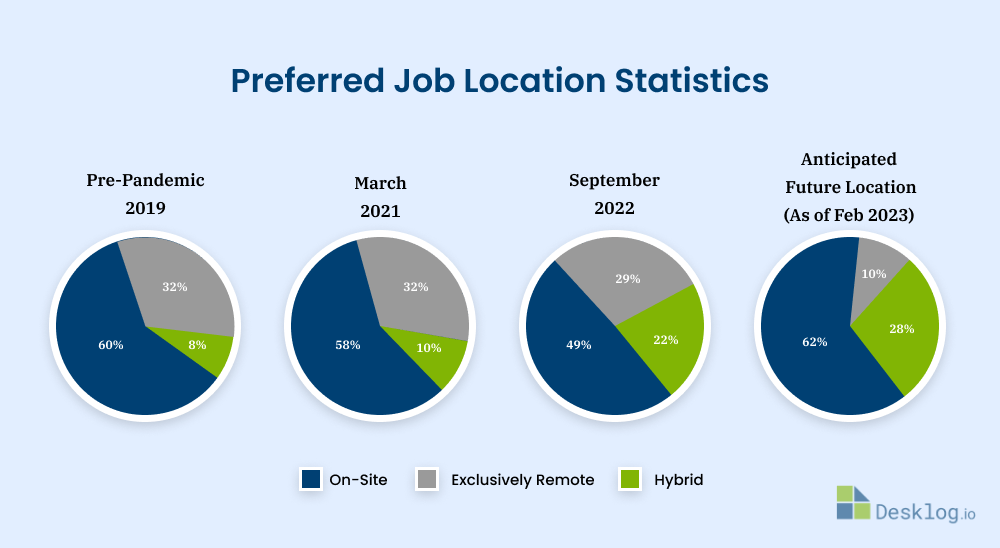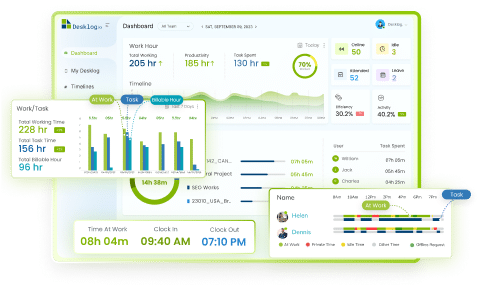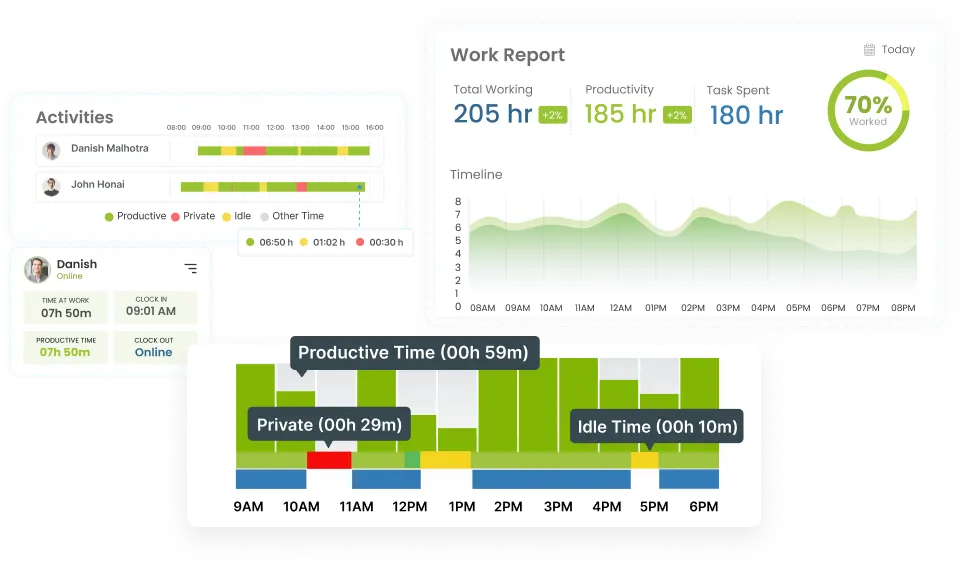How to Manage Hybrid Work Using Time Tracking Software?
The COVID-19 pandemic has forced organizations to re-evaluate their workplace strategies, with many organizations opting for a hybrid work.So what is a hybrid work model? A hybrid work model is where employees work in-offices and remote work that offers maximum flexibility. Hybrid work culture has its advantages, but it also presents challenges, such as how to manage productivity and maintain work-life balance.
Time tracking softwares can be a helpful tool to manage hybrid work as it can help you set goals, track progress, and stay on top of deadlines. They can also help you identify areas where you need to improve and make adjustments to your work schedule.
In this blog post, we will discuss the benefits of using time tracking tools to manage hybrid work. We will also provide some tips on how to choose the right tool for your needs.
Advantages of Hybrid Work
The Pros for Organizations

Reduced Operational Cost
Everything comes under operational cost, from office space and equipment to employee payments. Hybrid work models help you reduce these costs as the team work remotely and on-site alternatively.

Increased Employee Retention
Hybrid work provides employees greater flexibility in their work schedule, offering work-life balance. Besides, it also gives certain allowances to employees, which encourages them to stay as their expenses become less.

Reduced Absenteeism
A hybrid workforce offers much more flexibility than a strict on-site workforce. This helps to reduce absenteeism as employees can adjust their work schedules to address personal priorities without taking an entire day off.

More Efficient Workplaces
A hybrid work model will have lesser employees on-site on any day. This means your office will be less crowded. This creates an efficient space and peaceful environment hence, builds productive team.
The Pros for Workers

Cost Savings
According to Flexjobs, an average person can save about $6,000 per year working remotely. Hybrid work has a great impact on expenses related with traditional office-based work environments like meals, transportation, and clothing.

Greater Work Life Balance
Hybrid work allows you to work from home on some days and in the office on others. This can help workers to manage their time & structure their workday to suit their working style and life priorities.

Better Sleep & Own Time
Workers who get an average of 8 hours of sleep are nearly twice as productive as those who only receive 5. So, employees who work from home can benefit from having less commute time by sleeping better.

Boost Productivity
The Most satisfied employee will be the most productive one. As a hybrid work model provides work life balance, cost savings, more own time, and better sleep, it builds the most productive teams.
Disadvantages of Hybrid Work
No working model comes with only benefits. There will be some drawbacks to consider and that goes with hybrid work too. Let’s look at some disadvantages of the hybrid working model.

Harder to Collaborate
It might be harder for remote teams to communicate with those on-site, and vice versa.You can’t resolve your remote team’s WiFi speed or other distractions they face.
But there are a few things you could do to ensure effective communication and collaboration.
- Ensure that you are providing high quality support across all settings. A top-notch video and audio equipment must be available for your on-site and off-site employees.
- Equip your teams with chatting tools like Zoom, Google Meet and Slack etc. These tools ensure good communication with each other.
- Use Time tracking software to get insight on employee activities despite their working location.

Employee Burnouts
Hybrid work models may seem to prevent burnout. But that isn’t the case. Remote team may work longer hours and take fewer breaks than on-site team. They might even feel guilty for opting for remote work.
On the other hand, your on-site employees will have to work on long commutes, keeping aside their personal routines, or family emergencies. This culture may create burnouts for both remote and on-site employees.
Thus, it’s critical to create a flexible work schedule. With a time tracking tool you can easily create work schedules for your employees.

Not For All industries
Hybrid work models may not go right for every industry. Some organizations require a full on-site while some don’t. We may notice companies with fewer employees may prefer on-site work models, whereas those with more employees may prefer a hybrid work model.
Regardless of your industry or size, the key to a successful work plan is to adapt it to your team’s needs.

How Time Tracking Software Will Help You Manage a Hybrid Workforce
Time tracking software, such as Desklog, can assist managers in managing a hybrid workforce by offering a clear & realistic picture of employee work hours & activity. Both office-based and remote workers make up a hybrid workforce and can make it challenging for managers to track worker productivity.
Time tracking softwares are loaded with features like automated timesheet, leave management, idle time tracking, offline time tracking & many more. Regardless of whether an employee works at the office or from home, all of these features will assist in managing them.
Increase Accountability & Reduce Time Theft

It’s no secret that remote team have less visibility than their on-site counterparts. Needless to say, every good manager understands that trust is essential for success, but engagement issues can arise in digital workforces. Remote team may be tempted to use their lack of visibility to misrepresent the effort required for their jobs, or, worse, to stop working altogether.
Some remote time tracking software will even provide you access to reports that let you compare how well your staff works on-site vs off-site. This information can be used to support the case for work-from-home policies with higher management.
Time Savings in Employee Management
Managing a hybrid workforce means not only tracking employees’ location, but also their activities during working hours. A Time Tracking Software does this like a walk in the park.
A time tracking software provides automated reports of employee activities and performance analysis which saves your time spent on doing this chores manually. Further, this software generates invoices automatically based on employees’ productive time. Hence, a time tracking software is indeed a time saving tool.

Execute Hybrid Work Policy

A good communication, defined workplace culture, and a clear expectation makes a team successful. By enforcing a hybrid work policy you get access to all these factors.
Work policy can be effectively enacted by a time and productivity tracking software like Desklog. You can customize productivity tracking software according to the terms and conditions in the work policy. This helps to maintain and analyze the overall status of working hours, leaves, login-logout time either working in the office or remotely.
Tracking Hybrid Employees: Best Practices
Interested in using time tracking software with a hybrid workforce? Follow the tips and make your employees bring out the most out of them.
Tracking employees without their knowledge is a kind of crappy behaviour towards your employees. Needless to say, it will certainly create feelings of mistrust and build a poor image on your organization.
Thence, transparency plays a crucial role in building a robust relation between organizations and the employees. With transparency it’s easy to communicate your intention behind implementing the software. Besides, you can also make them understand the pros of using a time & productivity tracking software and how it helps them to become productive.
What you have to do is gather feedback from your employees and build a remote employee tracking model that respects employees’ privacy.
Using tracking tools with your hybrid team solely for the purpose of tracking is a recipe for disaster. Without proper knowledge about the role of a tracking software in your hybrid workforce, it’s hard to use the tool effectively.
So you should have an objective for tracking and ensure that your employees are aware of your purpose.
Your objective should be only to track their activities and working hours. And your prime goal should be making your employees productive.
A tracking software could bring privacy concerns and that’s a fact. Hence, it is important to have an employee tracking policy for your tracking tool.
Your employees might use the systems for their personal needs heedless of the risks involved. A perfect and advanced time tracking tool will have features like app & url tracking, Document Title tracking, and much more to ensure proper usage of your services.
And the most important part, never interfere in their privacy, that will cost you a lot. Only track them with their knowledge and consent. Use optional screenshots in your time tracking tool.
Using a time tracking software would not create any differences among off site employees and those working on site. This tool tracks employees’ check-in, check-out, productive working hours, and project timeline equally irrespective of their working model. Everything is balanced with time tracking software
Want to try our Time Tracking Software?
Try Desklog for free!

Endnote
As the trend of hybrid working continues to grow, it is more important than ever for businesses to understand how productivity tracking software can be used to manage their workforces and help optimize their operations.
Utilizing productivity & time tracking software will enable businesses to enjoy the benefits that hybrid workspaces offer, such as increased collaboration between onsite and remote teams, increased employee engagement, and improved morale. With these advantages in mind, implementing productivity & time tracking software should be a priority for any business looking to make the most of their hybrid workforce.
Make sure your company takes advantage of these Hybrid Workplace Benefits today!


















Great Blog on How to manage hybrid work with time tracking software